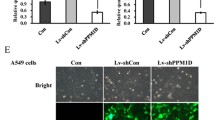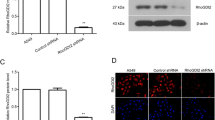Abstract
S100A4 (also known as pEL98/mts1/p9Ka/18A2/42A/calvasculin/FSP1/CAPL), a member of S100-related calcium-binding proteins, has been implicated to play a role in metastasis. In the present study, we examined the effect of antisense S100A4 RNA on metastatic potential of Lewis lung carcinoma (LLC) cells. High-metastatic A11 cells were transfected with the expression vector containing S100A4 cDNA in an inverted (antisense) orientation under the transcriptional control of the mouse metallothionein promoter. Treatment of a stably transfected clone (AS10 cells) with Zn2+ resulted in the suppression of the experimental metastatic ability, which was accompanied with the expression of antisense S100A4 RNA and the suppression of the S100A4 expression at both the mRNA and the protein levels. To further confirm the effect of antisense S100A4 RNA, we established several clones after retroviral transduction with an antisense S100A4 construct. Notably, reduced metastatic potential was also evident in these clones. In the antisense S100A4 RNA-expressing cells, cell motility and in vitro invasiveness were found to be suppressed.
Similar content being viewed by others
Author information
Authors and Affiliations
Rights and permissions
About this article
Cite this article
Takenaga, K., Nakamura, Y. & Sakiyama, S. Expression of antisense RNA to S100A4 gene encoding an S100-related calcium-binding protein suppresses metastatic potential of high-metastatic Lewis lung carcinoma cells. Oncogene 14, 331–337 (1997). https://doi.org/10.1038/sj.onc.1200820
Received:
Revised:
Accepted:
Issue Date:
DOI: https://doi.org/10.1038/sj.onc.1200820
- Springer Nature Limited
Keywords
This article is cited by
-
Overexpression of S100A4 Predicts Migration, Invasion, and Poor Prognosis of Hypopharyngeal Squamous Cell Carcinoma
Molecular Diagnosis & Therapy (2019)
-
S100 proteins as therapeutic targets
Biophysical Reviews (2018)
-
Efficient inhibition of tumor angiogenesis and growth by a synthetic peptide blocking S100A4-methionine aminopeptidase 2 interaction
Molecular Therapy - Methods & Clinical Development (2015)
-
Increased expression levels of S100A4 associated with hypoxia-induced invasion and metastasis in esophageal squamous cell cancer
Tumor Biology (2014)
-
Expression of S100A4, ephrin-A1 and osteopontin in non-small cell lung cancer
BMC Cancer (2012)




